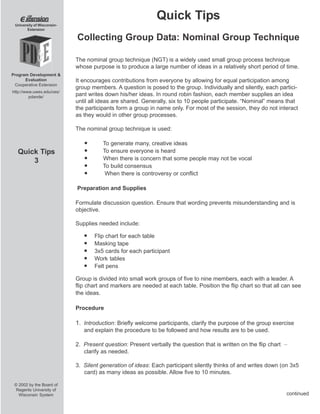More Related Content
Similar to Tipsheet_Nominal_Group_technique (20)
More from Siti Mastura (20)
Tipsheet_Nominal_Group_technique
- 1. E xtension
UW
Quick Tips
University of Wisconsin-
Extension
Collecting Group Data: Nominal Group Technique
The nominal group technique (NGT) is a widely used small group process technique
whose purpose is to produce a large number of ideas in a relatively short period of time.
Program Development &
Evaluation It encourages contributions from everyone by allowing for equal participation among
Cooperative Extension
group members. A question is posed to the group. Individually and silently, each partici-
http://www.uwex.edu/ces/
pdande/
pant writes down his/her ideas. In round robin fashion, each member supplies an idea
until all ideas are shared. Generally, six to 10 people participate. “Nominal” means that
the participants form a group in name only. For most of the session, they do not interact
as they would in other group processes.
The nominal group technique is used:
To generate many, creative ideas
Quick Tips To ensure everyone is heard
3 When there is concern that some people may not be vocal
To build consensus
When there is controversy or conflict
Preparation and Supplies
Formulate discussion question. Ensure that wording prevents misunderstanding and is
objective.
Supplies needed include:
Flip chart for each table
Masking tape
3x5 cards for each participant
Work tables
Felt pens
Group is divided into small work groups of five to nine members, each with a leader. A
flip chart and markers are needed at each table. Position the flip chart so that all can see
the ideas.
Procedure
1. Introduction: Briefly welcome participants, clarify the purpose of the group exercise
and explain the procedure to be followed and how results are to be used.
2. Present question: Present verbally the question that is written on the flip chart –
clarify as needed.
3. Silent generation of ideas: Each participant silently thinks of and writes down (on 3x5
card) as many ideas as possible. Allow five to 10 minutes.
© 2002 by the Board of
Regents University of
Wisconsin System continued
- 2. Quick Tips 3 - Collecting Group Data: Nominal Group Technique continued
4. Record ideas: In turn, each participant reads aloud one idea and it is recorded on the flip chart for all to see.
Continue until all ideas are depleted.
Discourage discussion, not even questions for clarification.
Encourage “hitchhiking,” i.e., expanding upon another’s statement. Ideas do not have to be from
the participant’s written list.
Participant may pass a turn and then add an idea at a subsequent turn.
Discourage combining ideas from individuals unless they are exactly the same.
5. Group discussion: After all ideas are recorded, the person who suggested the idea is given the opportu-
nity to explain it further.
Duplicates may be combined.
Wording may be changed if the originator agrees.
Ideas are deleted only by unanimous agreement.
Restrict discussion to clarify meaning; the value or merit of ideas is not discussed.
The nominal group technique often concludes with a prioritization process. However, generating ideas
alone is valuable and is useful in a situational analysis process.
References:
Delbecq, A., Van de Ven, A., & Gustafson, D. (1975). Group Techniques for Program Planning: A Guide to Nominal
Group and Delphi Processes. Glenview, IL: Scott, Foresman and Company.
Tague, N. (1995). The Quality Toolbox. Milwaukee, WI: ASQC Quality Press.
Witkin, B., & Altschuld, J. (1995). Planning and Conducting Needs Assessment: A Practical Guide. Thousands Oaks,
CA: Sage Publications.
Prepared by Ellen Taylor-Powell, Evaluation Specialist. Citation: Program Development and Evaluation, Collecting Group
Data: Nominal Group Technique, Quick Tips #3, University of Wisconsin-Extension, Madison, WI. © 2002 Available in PDF
format at http://www.uwex.edu/ces/pdande/resources/index.html or contact: pdande.webmaster@ces.uwex.edu Last updated
November 6, 2002

